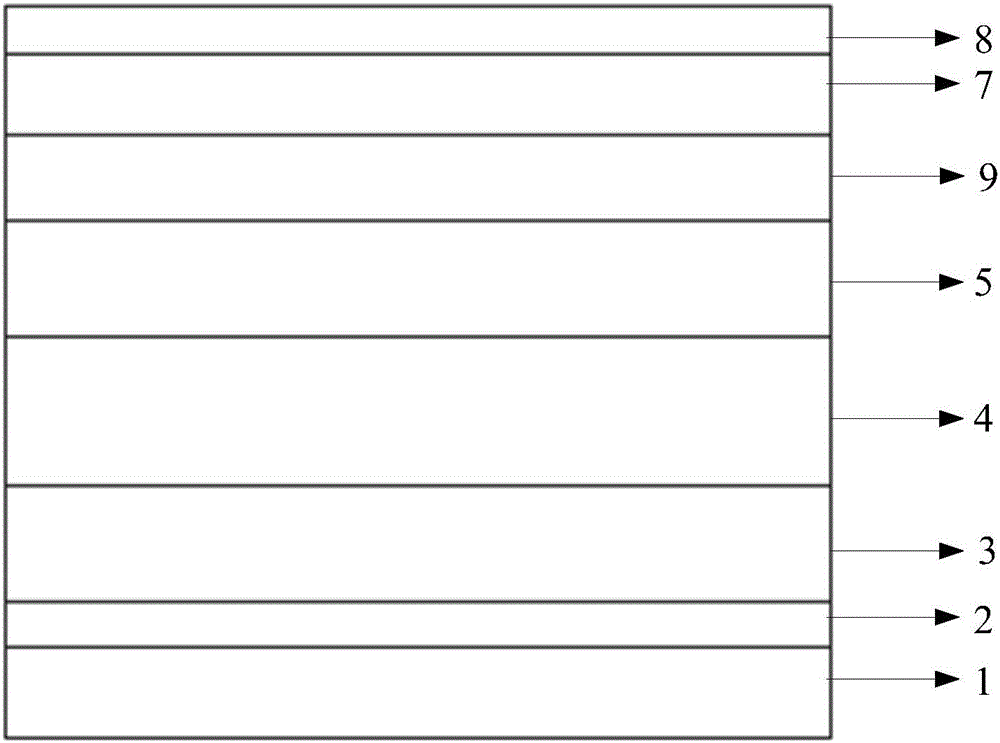LED epitaxial growth method
A technology of epitaxial growth and growth temperature, applied in the direction of electrical components, circuits, semiconductor devices, etc., can solve the problems of low p-AlGaN layer doping efficiency, insufficient hole injection, low activation rate of dopants, etc.
- Summary
- Abstract
- Description
- Claims
- Application Information
AI Technical Summary
Problems solved by technology
Method used
Image
Examples
Embodiment 1
[0051] The invention uses VEECO MOCVD to grow high-brightness GaN-based LED epitaxial wafers. Using high-purity H 2 or high purity N 2 (purity 99.999%) mixed gas as carrier gas, high-purity NH 3 (purity 99.999%) as N source, metal-organic source trimethylgallium (TMGa) as gallium source, trimethylindium (TMIn) as indium source, and N-type dopant as silane (SiH 4 ), trimethylaluminum (TMAl) as the aluminum source, and the P-type dopant as magnesium dicene (CP 2 Mg), the substrate is (001) sapphire, and the reaction pressure is between 100Torr and 1000Torr. The specific growth method is as follows:
[0052] A kind of LED epitaxial growth method, see figure 1 , including: processing the substrate, growing a low-temperature GaN nucleation layer, growing a high-temperature buffer layer GaN, growing an undoped u-GaN layer, growing a Si-doped n-GaN layer, growing a light-emitting layer, and growing a high-temperature p-type GaN layer , growing a p-type GaN contact layer, coolin...
Embodiment 2
[0062] The application examples of the LED epitaxial growth method of the present invention are provided below, and its epitaxial structure can be found in figure 2 , growth method see figure 1 . Using VEECO MOCVD to grow high-brightness GaN-based LED epitaxial wafers. Using high-purity H 2 or high purity N 2 or high purity H 2 and high purity N 2 The mixed gas as the carrier gas, high-purity NH 3 As the N source, the metal-organic source trimethylgallium (TMGa) is used as the gallium source, trimethylindium (TMIn) is used as the indium source, and the N-type dopant is silane (SiH 4 ), trimethylaluminum (TMAl) as the aluminum source, and the P-type dopant as magnesium dicene (CP 2 Mg), the substrate is (0001) sapphire, and the reaction pressure is between 100torr and 1000torr. The specific growth method is as follows:
[0063] Step 101, processing the substrate:
[0064] The sapphire substrate is annealed in a hydrogen atmosphere to clean the surface of the substrat...
Embodiment 3
[0092] A conventional LED epitaxial growth method is provided below as a comparative example of the present invention.
[0093] The growth method of conventional LED epitaxy is (for the epitaxial layer structure, see image 3 ):
[0094] 1. Anneal the sapphire substrate in a hydrogen atmosphere to clean the surface of the substrate at a temperature of 1050-1150°C.
[0095] 2. Lower the temperature to 500-620°C and feed NH 3 and TMGa, grow a 20-40 nm thick low temperature GaN nucleation layer with a growth pressure of 400-650 Torr.
[0096] 3. After the growth of the low-temperature GaN nucleation layer, stop feeding TMGa and perform in-situ annealing treatment. The annealing temperature is increased to 1000-1100 °C, and the annealing time is 5-10 minutes; after annealing, the temperature is adjusted to 900-1050 °C , continue to feed TMGa, and epitaxially grow a high-temperature GaN buffer layer with a thickness of 0.2-1um, and the growth pressure is 400-650 Torr.
[0097] ...
PUM
| Property | Measurement | Unit |
|---|---|---|
| Thickness | aaaaa | aaaaa |
| Thickness | aaaaa | aaaaa |
| Brightness | aaaaa | aaaaa |
Abstract
Description
Claims
Application Information
 Login to View More
Login to View More - R&D
- Intellectual Property
- Life Sciences
- Materials
- Tech Scout
- Unparalleled Data Quality
- Higher Quality Content
- 60% Fewer Hallucinations
Browse by: Latest US Patents, China's latest patents, Technical Efficacy Thesaurus, Application Domain, Technology Topic, Popular Technical Reports.
© 2025 PatSnap. All rights reserved.Legal|Privacy policy|Modern Slavery Act Transparency Statement|Sitemap|About US| Contact US: help@patsnap.com



